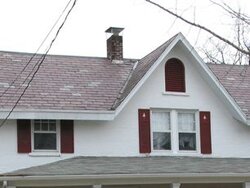Getting closer to choosing an insert and have definitely decided on the full chimney liner. Attached is a photo of my chimney. You can see the cover that has kept most weather and all but one very determined bird out. We always have the chimney (it's a double flue, one for the fireplace and one for the boiler) cleaned from below because of the slate roof. After spending $6k to have the roof rehabbed when we bought the house nobody goes up there but the slate roof crew. So I was reading some threads on chimney cleaning and they talked about cleaning the cap, which can only be done from above. In my situation, what would you advise?
I also read a number of conflicting opinions about a block off plate. Whether or not I use one, should I insulate above the stove going to the liner? Or around where the liner comes through the damper?
Thanks,
Anthony
I also read a number of conflicting opinions about a block off plate. Whether or not I use one, should I insulate above the stove going to the liner? Or around where the liner comes through the damper?
Thanks,
Anthony


